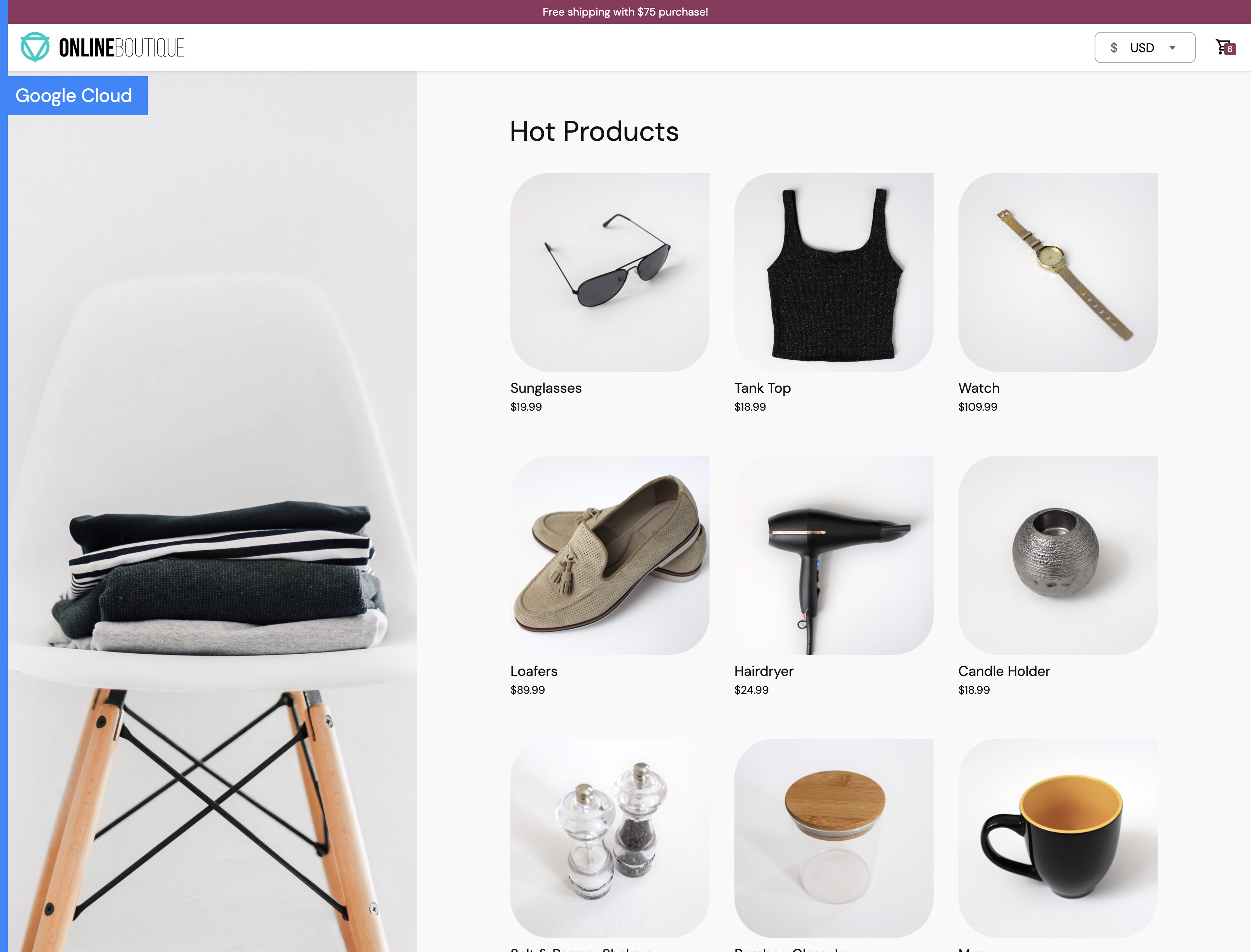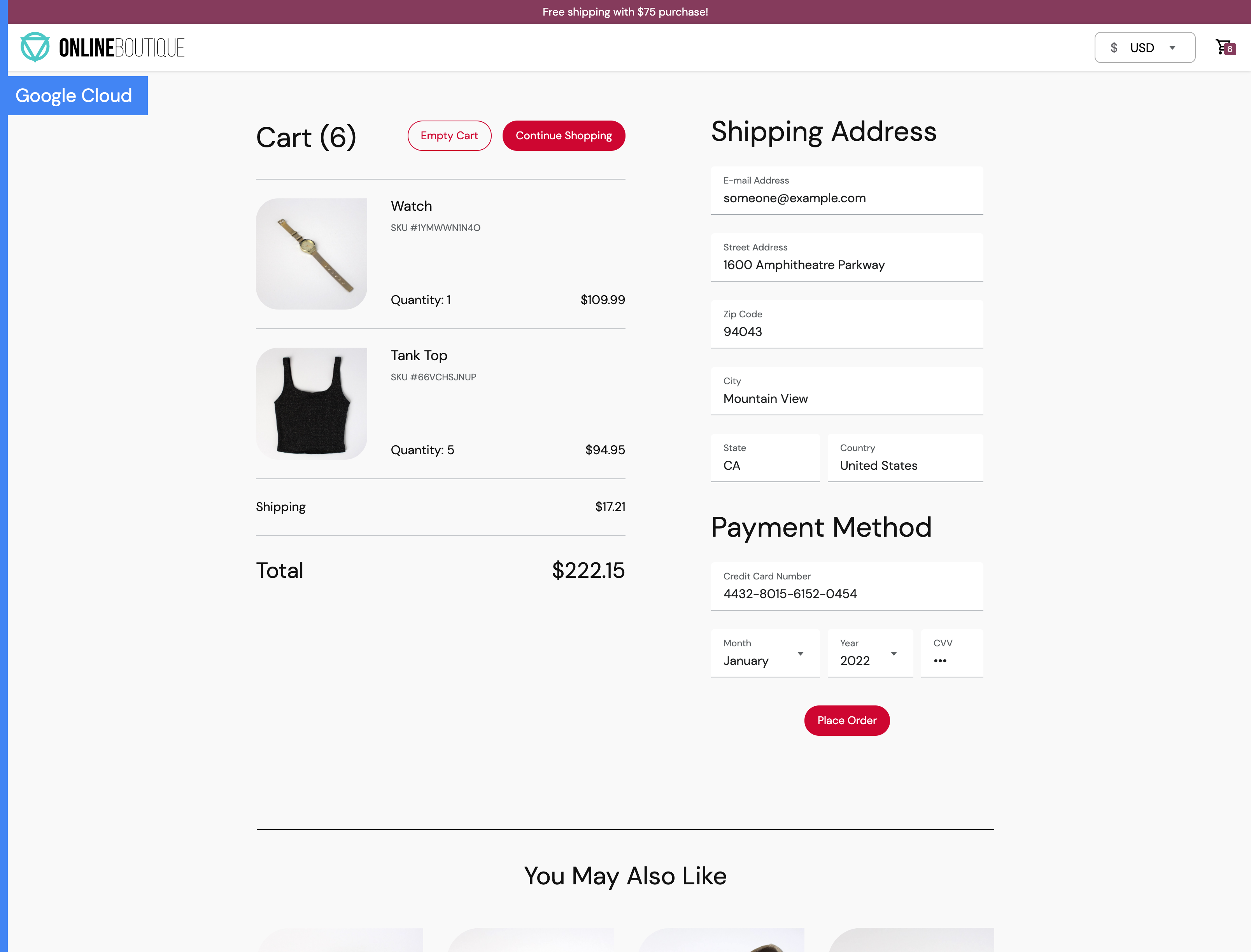This repository will explain how to deploy the various CNCF project to observe properly your Kubernetes cluster . This repository is based on the popular Demo platform provided by Google : The Online Boutique
Online Boutique is a cloud-native microservices demo application. Online Boutique consists of a 10-tier microservices application. The application is a web-based e-commerce app where users can browse items, add them to the cart, and purchase them. The Google HipsterShop is a microservice architecture using several langages :
- Go
- Python
- Nodejs
- C#
- Java
| Home Page | Checkout Screen |
|---|---|
 |
 |
The following tools need to be install on your machine :
- jq
- kubectl
- git
- gcloud ( if you are using GKE)
- Helm
First of all, build the demo image:
make buildThen, run the demo:
make runYou will first need a Kubernetes cluster with 2 Nodes. You can either deploy on Minikube or K3s or follow the instructions to create GKE cluster:
PROJECT_ID="<your-project-id>"
gcloud services enable container.googleapis.com --project ${PROJECT_ID}
gcloud services enable monitoring.googleapis.com \
cloudtrace.googleapis.com \
clouddebugger.googleapis.com \
cloudprofiler.googleapis.com \
--project ${PROJECT_ID}
ZONE=us-central1-b
gcloud container clusters create onlineboutique \
--project=${PROJECT_ID} --zone=${ZONE} \
--machine-type=e2-standard-2 --num-nodes=4
git clone https://github.com/observe-k8s/Observe-k8s-demo
cd Observe-k8s-demo
helm upgrade --install ingress-nginx ingress-nginx \
--repo https://kubernetes.github.io/ingress-nginx \
--namespace ingress-nginx --create-namespace
this command will install the nginx controller on the nodes having the label observability
Since we are using Ingress controller to route the traffic , we will need to get the public ip adress of our ingress. With the public ip , we would be able to update the deployment of the ingress for :
- hipstershop
- grafana
- K6
IP=$(kubectl get svc ingress-nginx-controller -n ingress-nginx -ojson | jq -j '.status.loadBalancer.ingress[].ip')
update the following files to update the ingress definitions :
sed -i "s,IP_TO_REPLACE,$IP," kubernetes-manifests/k8s-manifest.yaml
sed -i "s,IP_TO_REPLACE,$IP," grafana/ingress.yaml
helm repo add prometheus-community https://prometheus-community.github.io/helm-charts
helm repo update
helm install prometheus prometheus-community/kube-prometheus-stack --set sidecar.datasources.enabled=true --set sidecar.datasources.label=grafana_datasource --set sidecar.datasources.labelValue="1" --set sidecar.dashboards.enabled=true
To measure the impact of our experiments on use traffic , we will use the load testing tool named K6. K6 has a Prometheus integration that writes metrics to the Prometheus Server. This integration requires to enable a feature in Prometheus named: remote-writer
To enable this feature we will need to edit the CRD containing all the settings of promethes: prometehus
To get the Prometheus object named use by prometheus we need to run the following command:
kubectl get Prometheus
here is the expected output:
NAME VERSION REPLICAS AGE
prometheus-kube-prometheus-prometheus v2.32.1 1 22h
We will need to add an extra property in the configuration object :
enableFeatures:
- remote-write-receiver
so to update the object :
kubectl edit Prometheus prometheus-kube-prometheus-prometheus
After the update your Prometheus object should look like :
apiVersion: monitoring.coreos.com/v1
kind: Prometheus
metadata:
annotations:
meta.helm.sh/release-name: prometheus
meta.helm.sh/release-namespace: default
generation: 2
labels:
app: kube-prometheus-stack-prometheus
app.kubernetes.io/instance: prometheus
app.kubernetes.io/managed-by: Helm
app.kubernetes.io/part-of: kube-prometheus-stack
app.kubernetes.io/version: 30.0.1
chart: kube-prometheus-stack-30.0.1
heritage: Helm
release: prometheus
name: prometheus-kube-prometheus-prometheus
namespace: default
spec:
alerting:
alertmanagers:
- apiVersion: v2
name: prometheus-kube-prometheus-alertmanager
namespace: default
pathPrefix: /
port: http-web
enableAdminAPI: false
enableFeatures:
- remote-write-receiver
externalUrl: http://prometheus-kube-prometheus-prometheus.default:9090
image: quay.io/prometheus/prometheus:v2.32.1
listenLocal: false
logFormat: logfmt
logLevel: info
paused: false
podMonitorNamespaceSelector: {}
podMonitorSelector:
matchLabels:
release: prometheus
portName: http-web
probeNamespaceSelector: {}
probeSelector:
matchLabels:
release: prometheus
replicas: 1
retention: 10d
routePrefix: /
ruleNamespaceSelector: {}
ruleSelector:
matchLabels:
release: prometheus
securityContext:
fsGroup: 2000
runAsGroup: 2000
runAsNonRoot: true
runAsUser: 1000
serviceAccountName: prometheus-kube-prometheus-prometheus
serviceMonitorNamespaceSelector: {}
serviceMonitorSelector:
matchLabels:
release: prometheus
shards: 1
version: v2.32.1
kubectl apply -f prometheus/PrometheusRule.yaml
kubectl create secret generic addtional-scrape-configs --from-file=prometheus/additionnalscrapeconfig.yaml
kubectl apply -f prometheus/Prometheus.yaml
PROMETHEUS_SERVER=$(kubectl get svc -l app=kube-prometheus-stack-prometheus -o jsonpath="{.items[0].metadata.name}")
GRAFANA_SERVICE=$(kubectl get svc -l app.kubernetes.io/name=grafana -o jsonpath="{.items[0].metadata.name}")
ALERT_MANAGER_SVC=$(kubectl get svc -l app=kube-prometheus-stack-alertmanager -o jsonpath="{.items[0].metadata.name}")
kubectl apply -f https://github.com/jetstack/cert-manager/releases/download/v1.6.1/cert-manager.yaml
kubectl get svc -n cert-manager
After a few minutes, you should see:
NAME TYPE CLUSTER-IP EXTERNAL-IP PORT(S) AGE
cert-manager ClusterIP 10.99.253.6 <none> 9402/TCP 42h
cert-manager-webhook ClusterIP 10.99.253.123 <none> 443/TCP 42h
kubectl apply -f https://github.com/open-telemetry/opentelemetry-operator/releases/latest/download/opentelemetry-operator.yaml
helm repo add grafana https://grafana.github.io/helm-charts
helm repo update
kubectl create ns tempo
helm upgrade --install tempo grafana/tempo --namespace tempo
TEMPO_SERICE_NAME=$(kubectl get svc -l app.kubernetes.io/instance=tempo -n tempo -o jsonpath="{.items[0].metadata.name}")
sed -i "s,TEMPO_SERVICE_TOREPLACE,$TEMPO_SERICE_NAME," kubernetes-manifests/openTelemetry-manifest.yaml
sed -i "s,PROM_SERVICE_TOREPLACE,$PROMETHEUS_SERVER," kubernetes-manifests/openTelemetry-manifest.yaml
CLUSTERID=$(kubectl get namespace kube-system -o jsonpath='{.metadata.uid}')
sed -i "s,CLUSTER_ID_TOREPLACE,$CLUSTERID," kubernetes-manifests/openTelemetry-manifest.yaml
helm install fluent-operator --create-namespace -n kubesphere-logging-system https://github.com/fluent/fluent-operator/releases/download/v1.0.0/fluent-operator.tgz
kubectl create ns loki
helm upgrade --install loki grafana/loki --namespace loki
kubectl wait pod -n loki -l app=loki --for=condition=Ready --timeout=2m
LOKI_SERVICE=$(kubectl get svc -l app=loki -n loki -o jsonpath="{.items[0].metadata.name}")
sed -i "s,LOKI_SERVICE_TOREPLACE,$LOKI_SERVICE," fluent/ClusterOutput_loki.yaml
kubectl apply -f fluent/fluentbit_deployment.yaml -n kubesphere-logging-system
kubectl apply -f fluent/ClusterOutput_loki.yaml -n kubesphere-logging-system
kubectl create namespace kubecost
helm repo add kubecost https://kubecost.github.io/cost-analyzer/
helm install kubecost kubecost/cost-analyzer --namespace kubecost --set kubecostToken="aGVucmlrLnJleGVkQGR5bmF0cmFjZS5jb20=xm343yadf98" --set prometheus.kube-state-metrics.disabled=true --set prometheus.nodeExporter.enabled=false --set ingress.enabled=true --set ingress.hosts[0]="kubecost.$IP.nip.io" --set global.grafana.enabled=false --set global.grafana.fqdn="http://$GRAFANA_SERVICE.default.svc" --set prometheusRule.enabled=true --set global.prometheus.fqdn="http://$PROMETHEUS_SERVER.default.svc:9090" --set global.prometheus.enabled=false --set serviceMonitor.enabled=true
sed -i "s,IP_TO_REPLACE,$IP," kubecost/kubecost_ingress.yaml
kubectl apply -f kubecost/kubecost_ingress.yaml -n kubecost
sed -i "s,ALERT_MANAGER_TOREPLACE,$ALERT_MANAGER_SVC," kubecost/kubecost_cm.yaml
sed -i "s,PROMETHEUS_SVC_TOREPALCE,$PROMETHEUS_SERVER," kubecost/kubecost_cm.yaml
sed -i "s,GRAFANA_SERICE_TOREPLACE,$GRAFANA_SERVICE," kubecost/kubecost_nginx_cm.yaml
kubectl apply -n kubecost -f kubecost/kubecost_cm.yaml
kubectl apply -n kubecost -f kubecost/kubecost_nginx_cm.yaml
kubectl delete pod -n kubecost -l app=cost-analyzer
echo "adding the various datasource in Grafana"
sed -i "s,LOKI_TO_REPLACE,$LOKI_SERVICE," grafana/prometheus-datasource.yaml
sed -i "s,TEMPO_TO_REPLACE,$TEMPO_SERICE_NAME," grafana/prometheus-datasource.yaml
kubectl apply -f grafana/prometheus-datasource.yaml
kubectl apply -f kubernetes-manifests/openTelemetry-manifest.yaml
kubectl create ns hipster-shop
sed -i "s,PROMETHEUS_SVC_TOREPALCE,$PROMETHEUS_SERVER," kubernetes-manifests/k8s-manifest.yaml
kubectl apply -f kubernetes-manifests/k8s-manifest.yaml -n hipster-shop
gcloud container clusters delete onlineboutique \
--project=${PROJECT_ID} --zone=${ZONE}
Online Boutique is composed of 11 microservices written in different languages that talk to each other over gRPC. See the Development Principles doc for more information.
Find Protocol Buffers Descriptions at the ./pb directory.
| Service | Language | Description |
|---|---|---|
| frontend | Go | Exposes an HTTP server to serve the website. Does not require signup/login and generates session IDs for all users automatically. |
| cartservice | C# | Stores the items in the user's shopping cart in Redis and retrieves it. |
| productcatalogservice | Go | Provides the list of products from a JSON file and ability to search products and get individual products. |
| currencyservice | Node.js | Converts one money amount to another currency. Uses real values fetched from European Central Bank. It's the highest QPS service. |
| paymentservice | Node.js | Charges the given credit card info (mock) with the given amount and returns a transaction ID. |
| shippingservice | Go | Gives shipping cost estimates based on the shopping cart. Ships items to the given address (mock) |
| emailservice | Python | Sends users an order confirmation email (mock). |
| checkoutservice | Go | Retrieves user cart, prepares order and orchestrates the payment, shipping and the email notification. |
| recommendationservice | Python | Recommends other products based on what's given in the cart. |
| adservice | Java | Provides text ads based on given context words. |
| loadgenerator | JS /K6 | Continuously sends requests imitating realistic user shopping flows to the frontend. |
